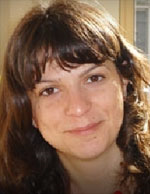Anat Katz on Curtain Up: Curtain 3- Come Closer by Merav Dagan and Stav Marin

english follows *
“פארוקסיזם היסטרי – על עבודתן של סתיו מרין ומירב דגן “תתקרבי
עילפון, עצבנות, תחושת כבדות בבטן, התכווצויות שרירים וקוצר נשימה – אלה רק חלק מהתסמינים למחלה “היסטריה נשית” כפי שהייתה ידועה במחצית השניה של המאה ה-19. הטיפול ב”מחלה” כלל עיסוי אגן בדרכים שונות ומשונות על ידי רופא מומחה או מיילדת עד לכדי אורגזמה ושחרור. העומס בנשים החולות בהסטריה הביא להתקדמות מהירה בחיפוש אחר טיפול מהיר יותר והביא במהרה להמצאתו של הויברטור הראשון בשנת 1873 שהופעל בבית חולים פסיכיאטרי בצרפת לצורך טיפול בהיסטריה. מחלת “ההסטריה הנשית” אולי נעלמה מספרי הרפואה בעולם המודרני, אבל תסמיניה נשארו צרובים בתודעה הציבורית במשך שנים רבות. בד בבד עם התקדמות החשיבה האנושית והשחרור מדעות קדומות התופסות את הנשים כהסטריות, אנחנו נתקלות לא פעם בחיי היום היום במי שינקה את האבק מעל אותם ספרי רפואה ויחזיר את ההסתכלות על המין הנשי כהסטרי, הגזמתי, וכזה שמקים מהומה רבה על לא דבר.
תסמיני המחלה באים לביטוי על הבמה בעבודתן של סתיו מרין ומירב דגן “תתקרבי” בצורת התכווצויות שרירים חוזורת ונשנות, כמו ריטואל בלתי פוסק, תוך כדי נסיון לדיבור או לפחות לחילוץ כמה הברות, יצירת קוצר נשימה עד כדי עילפון, המבוטא כשהאחת אוחזת את השניה הנופלת אל זרועותיה באנחה רמה ודרמטית. היוצרות משתמשות בביטויים גופניים אלו כמראה ביקורתית על תפקידן כנשים מול מערכת חברתית ופוליטית ותפקידן כנשים אחת אל מול השניה. הוורטואזיות של השתיים בביצוע רעידות בלתי פוסקות של הגוף במשך דקות ארוכות, תוך כדי שילוב הברות שנשמעות כל פעם כלקוחות מסיטואציות שונות: שיחת רכילות, סיפור אישי, בקשה לנחמה אימהית או להיט פופ מביאה להגחכת תפיסת הנשים כדמויות מוגזמות והסטריות.
לצד הגחכת ההסטריה, אי אפשר להתעלם מהקצב המסחרר והבלתי פוסק של הגוף. המאמץ ניכר דרך גוף הצופה שמכווץ אף הוא נוכח חוסר הנשימה על הבמה, ומביא לכך שהצופה פועל בתוך כסאו שלו. התנועות הבלתי פוסקות מייצגות מאבק שאינו נגמר על מקומן של הנשים בתוך החברה, לא רק מולנו, אל מול הקהל, אלא גם אחת אל מול השניה. נדמה כי היוצרות מניעות ומרגיעות אחת את השניה באותה הנשימה, נאבקות גם בעצמן על מיקומן ועל תפיסתן כנשים. התלבושת המרושלת בכוונה תחילה, התחתונים המציצים מתוך בגד הגוף והחזיה התפורה מעל החולצה, מחזקים את המלחמה באלמנטים הנתפסיים כנשיים כגון הקפדה על מראה ורמת אסתטיקה גבוהה, בכך שהשתיים מתעלמות מהרישול, לא מתקנות ולא מתייחסות כלל לבגד, אלא עסוקות אך ורק בתנועה, ברטט ובנשימה.
בנוסף, על הבמה נמצא סבך עלים, המכסה כמחצית מהבמה ונמשך עד למאחורי הקלעים. בקצה השני של הבמה – סלע איתן. לכשהתנועות הרפיטטיביות נפסקות, מגיעות השתיים אל הסלע מטפסות ומתיישבות עליו בתנוחה שנראית לא נוחה – כמו בנות ים שיצאו מהים לנוח על סלע. הן פוצחות בשירה של הברה אחת בלבד, שנעה בין קקופניה מוחלטת לבין הרמוניה מוזיקלית. חלק זה נדמה כמו מסכם את כל השיחות שנעשו על הבמה – במקום הברות לא ברורות עכשיו יש שיר עם הברה אחת בלבד. הנשים, היפות, ישובות כדוגמניות, שרות שיר ללא מילים, וניראות לרגעים כתרנגולות המקרקרות ומניעות ראשן לצדדים. המאבק לא הגיע לקיצו וכנראה לא יגיע. אין מסקנה סופית, יש רק מנוחה (אסתטית ויפה כיאה לנשים) לקראת המערכה הבאה.
Female Hysteria- On Merav Dagan and Stav Marin’s Come Closer
Fainting, edginess, heaviness of the abdomen, muscular contractions and shortness of breath- these are just a few of the symptoms associated with the disorder “Female Hysteria”, as it was known in the middle of the 19th century. Treatment for this “disorder” included a variety of pelvic massages that were performed by doctors or midwives to bring on orgasm and release. The overwhelming number of women suffering from “female hysteria” propelled a rushed search for more efficient treatment methods, resulting in the invention of the first vibrator in 1873. The vibrator was first used in a French psychiatric institution to treat hysteria. “Female Hysteria” may have disappeared from modern medical textbooks however its imprint remained etched in public consciousness for many years. In spite of progressive thinking and the release of preconceived notions of women as hysterical, we regularly encounter individuals who would happily dust off the old books and return the regard to the female gender as hysterical, exaggerative, and one to make a fuss over nothing.
The symptoms of this disorder are present on stage in Merav Dagan and Stav Marin’s Come Closer, in the contracting and releasing of muscles in a never-ending ritual, while attempting to speak or at least to eke out a few syllables. Shortness of breath to the point of near collapse, one holds the other as she dramatically falls into her arms. The choreographers use these physical expressions as a critical representation of women in social and political systems and their place as women one versus the other. The virtuosity of the two in the execution of endless tremors over long periods of time, combining movement and vocalizations that sound as if they have been taken from different situations; gossiping, a personal story, a request for motherly comfort or a pop song results in the ridiculous representation of women as exaggerated and hysterical characters.
Next to the outrageous hysterics, it is impossible to ignore the dizzying and endless pace of the body. The effort is present even in the body of the viewer, making the audience active in their seats. The endless movement represents the ongoing struggle of women to find their place in society, not just in relation to us, the audience, but in relation to one another. It seems as though the choreographers incite and calm one another in the same breath, fighting within themselves for their place and their stance on women. The intentionally messy costumes, the underwear peeking out from beneath the leotard and the bra sewn over a shirt, strengthen the war on elements that are taken as feminine such as presentability and attention to appearance. The two ignore the messiness, they don’t fix it or relate to it or the clothing at all. They are concerned only with movement, vibration and breath.
In addition, a chain of leaves sits on stage, which covers half of the space and continues into the wings. At the other end of the stage sites a boulder. When the repetitive movements come to an end, the two arrive at the boulder, climb it and sit atop it in positions that appear uncomfortable- like two mermaids that emerged from the water to sit on a stone. They break into a single-syllable song, that moves between complete cacophony and musical harmony. This part seems to sum up all of their conversations until now- instead of unclear utterances there is a song. The women, beautiful, perched like models, sing without words, and look for brief moments like chickens bobbing their heads from side to side. The struggle has not ended and apparently will not end. There is no moral at the end of this story, there is just rest (aesthetic and beautiful as the women are), before the next act.

She studied in the professional training program of Kibbutz Ga’aton, under the artistic direction of Mrs. Yehudit Arnon. She hold a Master’s degree from the Tel Aviv University’s interdisciplinary department. Anat teaches dance theory and practice classes in various studios and schools around the country. Her choreographies have been presented by festivals in Israel (Intimadance, Shades of Dance, Arena Dance Festival, Acco Festival and more) and
.further afield (Germany, Croatia, Belgium, Great Britain and others
